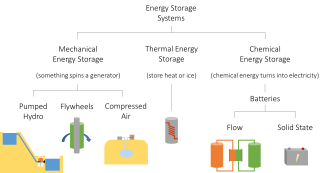Energy Storage
Energy storage systems, sometimes abbreviated ESS, store energy produced at one point in time for use at another time (or over a period of time). There are a variety of energy storage system technologies that vary based on the type of energy stored, the mechanism used for storing that energy, and the time over which the energy is stored and discharged.
Energy storage can have many benefits. In order for our electric grid to work, the same amount of electricity must be generated as is demanded at any given instant. Since energy storage systems can hold energy over time and discharge when needed, they allow our electric grid to be operated more economically and, potentially, at a lower carbon output.
RI Energy's ConnectedSolutions Program
Rhode Island Energy’s ConnectedSolutions program is designed to manage electricity use during peak demand times, particularly on hot summer days when the grid is under stress. The program helps lower energy costs and reduce pollution by offering solutions such as Wi-Fi thermostats and energy storage systems. By reducing peak demand, it also contributes to preventing blackouts and ensuring a more reliable, cost-effective power system for Rhode Island.
Click here for more information on the ConnectedSolutions Program
About Battery Storage
Battery storage is a specific type of energy storage system that use battery technology to store electrical energy in the battery’s chemical components. Similar to rechargeable batteries you use around the home, battery storage can charge and discharge many times. Click here to read more about battery storage in Rhode Island.
Other types of storage systems include Mechanical, Thermal, and Chemical systems. The figure below illustrates these different types of energy storage systems:
Figure 1: Types of energy storage systems

Want to learn more about energy storage systems?
Click here to view Rhode Island's Energy Storage StatisticsReports & Publications
- Public Utilities Commission's Final Report to the Rhode Island Senate in response to Resolution 416
- Understanding Solar and Storage
- Comprendiendo Solar and Almacenamiento
- Microgrids report
Related Links
Frequently Asked Questions
Energy storage is any technology that can store energy over time and discharge that energy when it is needed. A battery is an example of an energy storage technology.
Electric grid operators have traditionally had to balance the amount of electricity needed (load) with the amount of electricity generated (supply) at every given instant. Energy storage allows some wiggle-room between load and supply: If there is more supply than is needed by load, energy storage can absorb the excess supply. If there is more demand from load than there is supply, energy storage can release some electricity to cover the gap.
Energy storage can also provide other benefits like mitigating high costs during times of high demand, helping to adjust various qualities about the electricity to optimize grid performance and efficiency, and prevent the need for costly enhancements to the poles, wires, and substations that make up our electric grid.
Energy storage can lead to reduced costs. Our energy bills are essentially composed of two costs: the cost of electricity supply and the cost to deliver that electricity to your home or business. Energy storage can reduce supply costs by storing electricity produced at lower cost (like during times when demand is low and the most efficient, cheapest generation sources can be used) and discharging that electricity during times when it is most expensive to generate electricity (like the hottest summer days when everyone is running their air conditioners on high). Energy storage can reduce delivery costs by storing electricity generation in close proximity to where that electricity is needed. Doing so can reduce the need for costly upgrades to wires and substations.
Energy storage provides environmental benefits. First, energy storage can store electricity generated by renewable energy sources for use at another time. This makes it easier to integrated renewable energy onto the electric grid, thereby reducing the need for fossil-based generation sources. In this way, energy storage can help Rhode Island reduce its greenhouse gas emissions and meet its climate goals. Second, energy storage can help with resilience during extreme weather events or power outages. Place that have both renewables and energy storage can essentially act like their own ‘microgrid’ and run even when the main electric grid is down.
Energy storage is one technology that can help the state meet its clean energy goals. Energy storage can help match the timing of renewable energy generation with the timing of when we need electricity, particularly on the days when we use the most electricity. Energy storage can also help Rhode Islanders manage our energy consumption, our energy costs, and can play a role in enhancing energy resilience in our communities.
An energy storage system is an umbrella term that encompasses all technologies that have the ability to store and return energy. A battery energy storage system is a subset of energy storage technologies that use chemical technologies to store energy. A battery system is a shorthand term for battery energy storage system, typically used when referring to residential and commercial use cases. An energy storage facility is the set of energy storage technology and all ancillary equipment, including inverters, HVAC system components, fire suppression equipment, battery management system, and site ground preparation. A battery energy storage facility is an energy storage facility that uses battery technology. Storage facilities typically reference utility-scale use cases, as smaller systems need less ancillary equipment and are typically packaged into only one or two component parts.
A kilowatt, abbreviated kW, is a unit of power at a given instant. A kilowatt-hour, abbreviated kWh, is a unit of energy, which is the amount of power transferred over time. A battery system is rated in both kW and kWh. Consider a simplified example of a battery system that is rated 2 kW, 6 kWh. This system can discharge at a maximum of 2 kW power at any given instant. The battery has a capacity of 6 kWh, so in theory it can discharge 2 kW for three hours (2 kW * 3 h = 6 kWh). In actuality, discharging a battery does result in some losses which will impact actual energy output. Consult with your battery installer and manufacturer specifications for more information.
